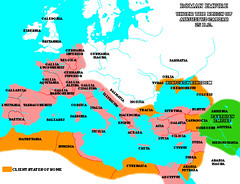Last week we recognized the Golden Age of Islam. An empire was created by Muslim warriors who sped out of Arabia in the century after the Prophet Muhammad's death. The armies took Persia, Syria, Judaea, Aegyptus and continued across North Africa. In 711 AD they crossed the Strait of Gibraltar and took Espana.
This week we see the map of the Roman Empire - some 600 years earlier. The Roman Empire included quite a bit more land. It entirely encompassed the Mediterranean.
The Pax Romana was a 200-year period of peace and stability throughout the empire. It began with the wise reign of Augustus Caesar, 27 BC, and continued to 180 AD. Thus we see Jesus of Nazareth born into the Pax Romana.
By the end of the Pax Romana the new religion called Christianity was spreading rapidly - using the roads and communications afforded by the widespread empire. The growth was non-violent.
By the year 300 the Roman emperor Constantine I had converted to Christianity. By the Edict of Milan he stopped the persecution of Christians. By 390 AD Christianity was the official religion of the empire.
Constantine's mother, Helen, went to Jerusalem and investigated the life of Jesus. Over the place of his crucifixion and burial she sponsored the building of the Church of the Holy Sepulchre.
Did Islam use an older empire in its rapid growth? Yes; it spread through the decaying Byzantine Empire.
Did the Jews ever command an empire?
Do we live in an era that could be called the Pax Americana? Your teacher says yes. Historians would not see the war in Iraq as a big deal, btw. Nor would our bombing of Afghanistan or the 9/11 attacks be seen as the end of an era of widespread stability.
Vocab:
* Judaeo-Christian ethic: the philosophical background of Euro-American society (to now).
* epiphany: a mental or emotional breakthrough - such as Lawrence's plan to attack Aqaba from the desert.
* blasphemy: to curse or be irreverent about God's matters.
* date palm: palm of SW Asia that produces a fruit something like a giant raisin. During Ramadan the prophet broke his fast with dates, so they are a favorite in Muslim houses. Americans make date loaf bread and use chopped dates in fruit cakes and trail mix.
* aquifer: underground water reservoir in porous rock. Makes an oasis possible.
* Aqaba: city on the edge of the upper end of the Red Sea (Gulf of Aqaba); on the border of Israel and Jordan.
* Arabia: why was Arabia never a priority in the ancient world? Because petroleum did not become important to the world until the era of WWII. Oil is their principal resource.
Haynes Gym, Centenary College. A beautifully renovated exercise center with an olympic pool. The CMHS swim team will host competitions here on Oct 19 and Nov 2 at 7 pm. Check it out.
Tuesday, October 18, 2005
Subscribe to:
Post Comments (Atom)


No comments:
Post a Comment